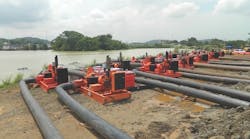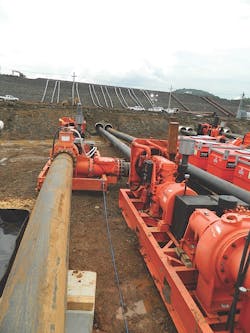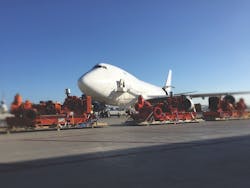Xylem, international water technology company and leading pump manufacturer and pump rental expert, is providing Godwin dewatering pumps to fill the third set of basin locks on the Pacific Ocean sector of the Panama Canal with 1.7 billion gallons of water. The Panama Canal Expansion Program is scheduled for completion during the second quarter of 2016. It will create a new traffic lane and build two new lock complexes, one on the Atlantic Ocean and the other on the Pacific, doubling the capacity of the canal.
The project is the second one that the Authority of the Panama Canal has awarded to Xylem. Earlier this year, Xylem supplied 64 Flygt mixers to prevent the formation of corrosive deposits on the rolling gates during installation.
“We are honored to work with the Authority of the Panama Canal and to be part of this project which expands one of the world’s most important transport routes,” said Colin Sabol, senior vice president and president of Xylem’s Dewatering business.
Xylem installed 15 Godwin diesel-driven pumps, deployed from the United States. In June, the pumps began transporting up to 122 million gallons of water per day from the Miraflores Lake to fill the third set of locks on the Pacific. During a 22-day period, the project consisted of pumping enough water to fill 90,000 average-sized swimming pools.
In addition to providing the equipment, Xylem’s engineers designed and installed the system, which also includes 13,500 feet of 18-inch high-density polyethylene pipeline to transfer the water. Xylem is also supervising the performance of the 15 Godwin pumps with its remote pump monitoring system called Field Smart Technology.
“Xylem is providing its global experience at a local level,” said Jorge Alvarado, managing director for Xylem Latin America North. “With the world’s largest inventory of rental pumps and related equipment, Xylem has the ability to mobilize our vast resources quickly.”
Colin Sabol, Xylem senior vice president and president of Xylem’s Dewatering Division, works out of Xylem’s Bridgeport, N.J., global headquarters. He spends about 30 percent of his time there and the rest of it “somewhere else in the world.” Included in his recent travels was a visit to the Panama Canal project. Sabol spoke about it with RER.
RER: Can you summarize the logistics of planning and preparing for a job of this magnitude?
Sabol: I had the pleasure of going down to Panama [recently], so I had a chance to see the jobsite in person, which was quite interesting for an old engineer to see the Panama Canal firsthand and the scale of it all.
We were contacted by the ACP, the Panama Canal Authority, in early May and they said that they wanted to have a system to pump up 1.7 million gallons of water into this new shipping channel. They wanted to have it on the ground, set up and ready to turn it on in 45 days. We had to gather up that much equipment, 2.5 miles of pipe, and an all-star team of our best people from the United States that know how to design and install these systems.
We were a little nervous about it frankly, just because the time frame was so tight. But the ACP was really good about helping us manage paperwork, and other things that often take a little longer to execute in Panama. We were able to get five 747s full of equipment shipped down there, get an all-star team on the ground to help actually set up the pumps and the 2.5 miles of pipe, all the control networks, all the remote monitoring equipment, the flow meters, commission the system and turn it on, and validate that it all worked actually ahead of schedule. So it was quite a feat for us, very invigorating for our entire global business. It was a very rewarding experience.
Is this the biggest job you’ve ever done?
No not the biggest, although it’s a big one. You don’t get these projects every year. But we do very large projects on a regular basis, such as the Big Dig project when they dug tunnels under the old city in Boston. We did all the dewatering work for that, that was a very large project. We do projects like a forage pump for a week all the way up to things like the Panama Canal; it’s a really wide range.
Even a job like this that pumped 1.7 billion gallons of water, it all starts with one pump pumping one gallon and it all depends on how long it runs and how much it pumps after that. But every job is important to us.
Did you run into any particular obstacles?
Once we got the logistics established, the five 747s, gathering up all the equipment from the U.S. and getting it commissioned and ready to go, it actually went quite smoothly. We had about 10 people from the U.S. that went down to Panama to assist the local team in doing the setup and the trouble-shooting. They were some of our very best people; that really made all the difference. And the Panama Canal Authority was anxious to get the system in place and commissioned on time so they were very helpful. They knocked down any barrier that came up.
The Panama Canal Authority is a first-class organization, one of the best run international large-scale infrastructure entities I’ve ever dealt with.
This expansion project is quite innovative. The Panama Canal basically has a lock at either end, one at the Atlantic and one at the Pacific, and in the middle there’s a giant lake. They’re building a second channel and a second set of locks. Back in the original development of the canal, ships were much smaller. Now they have these huge shipping vessels, and so they decided to build this second set of locks to be able to handle much larger ships. The original locks will still be functioning as they were before but this just adds a second set. All the ships will go through the same lake but they built a second set of locks. They simply use the elevation of the lake, which is different from the ocean, and use that to drive the locks.
In a project of this magnitude does Xylem staff remain onsite to maintain the pumps and make sure things are operating smoothly?
Xylem is in 150 countries around the world; we have an office in Panama, and have for many years. We have a managing director and a team there of technicians and engineers and people who are quite capable. We had to supplement that team to execute the job on such a short cycle, but the people who went down to set it up will also go back to decommission the system to take it all apart and ship it back home again. But they did not remain onsite. The local team is managing the system. We have from time to time sent an individual or two down to do some specialty work around the site, some re-engineering of a few areas based on some changing needs the authority had, but the local team is pretty much handling it.
We use Field Smart Technology on all of the pumps. There are 15 pumps and each one has its own control device that monitors the engine and pump performance, and their condition. It can sense whether there is a maintenance concern because of the time the pump has been running, or some other condition with the engine of the pump that is causing concern, in which case we have redundant equipment onsite that can support it. Also it calls in our local team to resolve the issue before it becomes a major issue for us. It’s monitored by us but also by the Panama Canal Authority right from their office.
How big are these pumps?
These are what we call our CD400 dri-prime pumps. Each one of these pumps is a 16-inch diameter pump. When all of them are running together they pump 122 million gallons of water per day, so they are pushing a lot of water. They are fairly low-head pumps, we have a full high-end high-head range of pumps to do different sorts of tasks, but in this case we just had to essentially lift the water up and over the wall of the new shipping channel.
How long will the project last?
The project is planning to be completed on their schedule right now in the second quarter of 2016, so in just about three quarters from now it will be done from their perspective, and we’ll be there to help them with this project and any one that goes beyond it.
Do you have rental business in all 150 countries Xylem operates in?
Xylem has a pretty wide range of offerings. But in those 150 countries around the world, we sell treatment equipment, analytical instrumentation, pumps, dewatering services, a wide range of solutions for water problems. We believe that water offers many challenges everywhere in the world, and most water challenges are very local in nature, and can’t be solved from a national capital someplace, they have to be solved locally, so we have local offices in 150 countries, and in many locations within those countries so that we can understand the local regulatory frameworks and local issues and help customers to solve whatever challenges may be in their local geography.
What can you share about the products and services Xylem is offering?
Xylem as a whole, I like to say that Xylem as a whole is in solving water, that’s what we do. The primary products that we offer are transport of water and wastewater, treatment of water and wastewater and testing of water and wastewater. So transport, treatment and testing. Transport is primarily pumps and pumping systems, valve control frameworks, and a great set of brands and pumps. The treatment is everything from brands like Wedeco, which is UV treatment, to Leopold, which is filtration, and wastewater treatment brands like Sanitaire. These brands and these products are all designed to clean water so that it can be reintroduced to the environment or reused or to clean water to make it potable for drinking.
So that’s our treatment business. And then the analytics business is one that makes testing and instrumentation devices for primarily online testing of water environments. So everything from transport to treatment to tests, that’s what Xylem does for water customers around the world.
As far as the rental industry, Xylem primarily selling Godwin and Flygt and you operate your own rental business?
There are two major brands that we bring to the dewatering marketplace, one is Godwin, and the other one is Flygt, which is known for wasterwater pumping in lift stations. But there’s also a full line of drainage pumps that are used by contractors, both large and small, all around the world. Our Flygt dewatering business and our Godwin dewatering business are about of equal size. We sell both and rent both of those product lines in all our locations around the world. So what’s pretty unique about our dewatering business is we manufacture the products that we rent and we rent the products that we manufacture and sell to other rental companies. Other rental companies love buying our equipment because if there ever was a problem, we’d be the first to know about it because it’s in our rental fleet, so they love that idea and people who are buying our equipment love the fact that we’re in the rental business because we’ve worked out all the kinks in advance. So it’s a nice synergistic relationship. And we do a lot of re-rental to rental companies.









